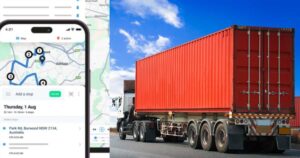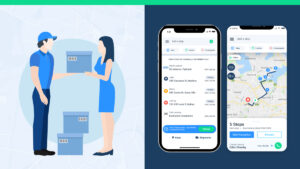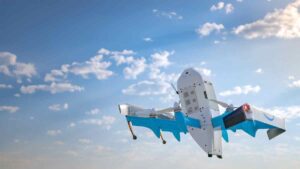One of your trucks carrying high-value electronics is en route to a distribution center. Everything is on track until hours pass without an update from the driver. If only you had GPS tracking software, you think to yourself.
You call – no response. Panic sets in.
Where is the truck? Is it stuck, hijacked, or worse? If you’ve been in logistics long enough, you know this scenario isn’t just paranoia. It’s reality.
But what if you had the power to pinpoint the truck’s exact location in seconds? That’s where a GPS tracker and GPS tracking software step in, acting as your eyes on the road, guiding shipments every mile of the journey.
GPS tracking software lets you monitor vehicle and cargo movement in real time. This technology isn’t just about maps and coordinates.
It’s about preventing lost shipments, reducing delivery hiccups, and ensuring customers stay happy.
Whether you manage a fleet of trucks transporting high-value machinery or run a small grocery delivery service, GPS tracking can save you from shipment disasters.
![]()
Real-time tracking: How to keep an eye on your vehicle tracking system
Think of GPS tracking as a virtual leash for your fleet. Without it, your trucks roam free, and you rely solely on driver communication. But drivers aren’t always available to update you. GPS tracking gives you real-time updates without needing to call or text.
Picture this: You manage a fleet of six trucks delivering appliances across the country. One morning, a driver is delayed in a remote area.
You can’t reach him. Instead of waiting, you check your GPS tracking dashboard. The system shows the truck stopped at a rest area. No guesswork, no unnecessary calls. You alert the client about the minor delay with confidence.
Key takeaway: You need fleet tracking software to see where your fleet is at all times – no blind spots.
Geofencing helps you set boundaries and prevent deviations
Geofencing lets you draw invisible borders on a map. When a truck crosses these lines, you get alerts. This is invaluable in preventing theft, unauthorized detours, or shipment mix-ups.
Here’s a scenario: A shipment of luxury watches is being transported. You’ve set a geofence around the approved route.
Midway through the trip, the truck veers off course. Instantly, you get a notification. You call the driver to find out there was confusion about the route. A quick correction prevents a potential loss.
Key takeaway: You need fleet tracking and GPS tracking software to catch route deviations the second they happen.
Why you need route optimization and fleet tracking software
Lost shipments don’t just vanish. Sometimes they’re stuck in transit due to poor route planning. GPS tracking software can analyze traffic, roadblocks, and delivery windows to choose the fastest route.
Route optimization will bring your delivery full circle and help you deliver even better.
Picture this: Your courier company promises same-day delivery. One truck carrying medical supplies hits heavy traffic, risking a missed deadline.
The GPS tracking system reroutes the driver through a side road, bypassing the jam and saving the delivery.
Key takeaway: You need a vehicle tracking system to ensure drivers take the fastest, safest routes.
GPS tracking software gives drivers accountability
Drivers are human. Sometimes they take detours, extend breaks, or even falsely claim deliveries. GPS tracking keeps drivers honest and accountable.
Additionally, monitoring harsh driving events can provide insights into driver behavior and help improve safety.
Here’s a scenario: You receive a complaint from a customer claiming their shipment hasn’t arrived.
Your driver insists they delivered it. A quick look at the GPS data shows the truck never stopped at the delivery address. With evidence in hand, you address the issue, ensuring the correct delivery happens the next day.
Key takeaway: You need GPS tracking software to hold drivers accountable for every mile.
![]()
How GPS tracking software helps with customer transparency
Customers hate uncertainty. GPS tracking lets you provide shipment updates down to the minute, improving trust and satisfaction.
Here’s a scenario: A client orders custom furniture from your company. The delivery date is set, but weather delays the shipment. Instead of leaving the client guessing, you share a live tracking link. They monitor the progress and stay informed, reducing frustration.
Key takeaway: You need location and GPS tracking software to give customers the visibility they crave.
Proof of Delivery: No more “lost in transit” excuses
Shipments sometimes mysteriously disappear. GPS tracking lets you prove where your vehicle was at the time of delivery. Proof of delivery can help you mitigate lost shipments.
Here’s a scenario: A delivers expensive machinery to a warehouse. Weeks later, the client claims it never arrived. The GPS records show the exact time and location where the delivery occurred. Dispute resolved.
Key takeaway: You need GPS tracking software to prove deliveries and avoid false claims, especially for fleet vehicles.
GPS tracking software helps your business maximize every trip
Underutilized vehicles cost you money. GPS tracking shows which trucks are being used and which are sitting idle.
Here’s a scenario: Your logistics company owns 20 trucks. GPS tracking reveals that five trucks consistently handle the majority of shipments, while others sit unused. You adjust schedules to distribute the load evenly, improving efficiency.
Key takeaway: You need a fleet management platform to maximize vehicle utilization.
![]()
Choosing the right GPS tracking software
Choosing the right GPS tracking system for your business can feel overwhelming with so many options available.
However, by focusing on a few key factors, you can make an informed decision that aligns with your specific needs.
Scalability: Imagine your business starts with a small fleet of five vehicles, but you plan to expand to 50 in the next few years. You need a GPS tracking system that can grow with you, scaling up or down as your fleet size changes.
Accuracy: Accurate location tracking is crucial. For instance, if you’re managing a fleet of delivery trucks, knowing the precise location of each vehicle in real-time can help you reroute them efficiently during traffic jams or road closures.
Ease of Use: A user-friendly interface is essential.
Picture this: your team needs to quickly learn and navigate the system without extensive training. A simple, intuitive dashboard can save time and reduce errors.
Customization: Every business has unique needs. Whether you need specific reports, custom alerts, or tailored features, a customizable GPS tracking system can adapt to your requirements.
Integration: If you already use fleet management software or other systems, seamless integration is a must. This ensures that all your tools work together harmoniously, streamlining operations and improving efficiency.
By considering these factors, you can choose a GPS tracking system that not only meets your current needs but also supports your business as it grows and evolves.
GPS tracking software: Advanced features
Advanced features and integrations can take your GPS tracking system to the next level, offering additional benefits that enhance your operations.
Geofencing: Imagine setting up virtual boundaries around your delivery routes. If a vehicle strays from its designated path, you receive an instant alert. This feature is invaluable for preventing unauthorized detours and ensuring shipments stay on track.
Driver Behavior Monitoring: Monitoring driver behavior can significantly improve safety. For example, if a driver frequently engages in harsh braking or speeding, the system can alert you, allowing you to address these risky behaviors and promote safer driving practices.
Fuel Consumption Monitoring: Keeping an eye on fuel consumption helps manage costs. Suppose you notice a vehicle idling excessively or consuming more fuel than usual. You can take corrective action, such as scheduling maintenance or coaching the driver on more efficient driving habits.
Vehicle Maintenance Scheduling: Regular maintenance is key to keeping your fleet in top condition. A GPS tracking system can remind you when maintenance is due, helping you avoid unexpected breakdowns and extend the lifespan of your vehicles.
Integration with Other Systems: Integrating your GPS tracking system with other tools, like fleet management software, can streamline your operations. For instance, combining location data with maintenance schedules and driver logs provides a comprehensive view of your fleet’s performance.
These advanced features and integrations not only enhance the functionality of your GPS tracking system but also contribute to more efficient and cost-effective fleet management.
Let’s recap: How GPS tracking software can help your logistics operations
Running a logistics operation without GPS tracking is like sailing without a compass. Every shipment matters, and losing even one can damage your reputation and finances.
If you’re serious about preventing lost shipments, saving costs, and keeping customers happy, GPS tracking is an important tool for your logistics operations.
About the author
Sharl is a qualified journalist. He has over 10 years’ experience in the media industry, including positions as an editor of a magazine and Business Editor of a daily newspaper. Sharl also has experience in logistics specifically operations, where he worked with global food aid organisations distributing food into Africa. Sharl enjoys writing business stories and human interest pieces.










